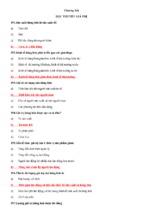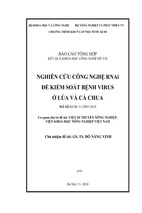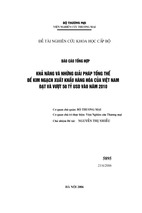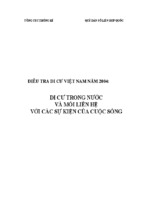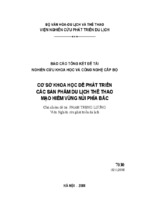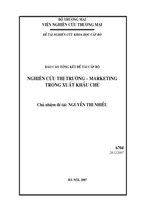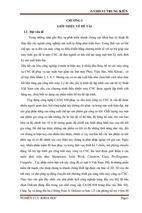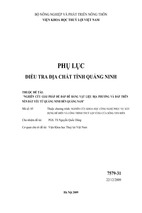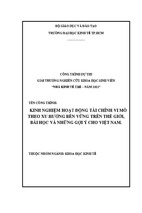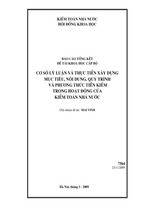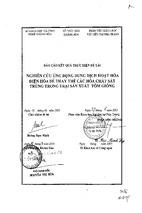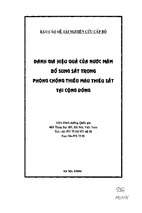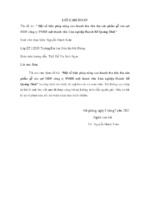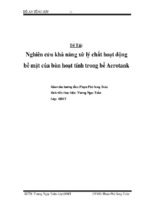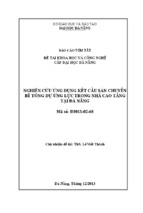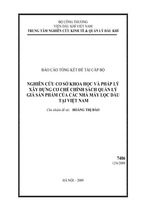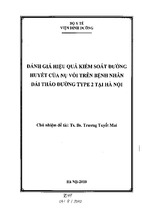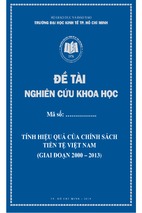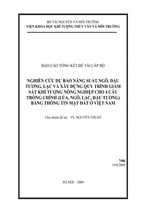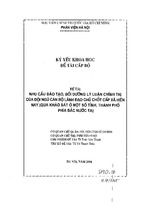Attracting Foreign Direct Investment: A Critical Analysis of
Vietnam’s Performance
A thesis submitted in fulfilment of the requirements
for the degree of doctor of philosophy
Thanh Hoa Le
Master of Management, University of South Australia, Australia
Bachelor of Law, University of Law Ho Chi Minh City, Vietnam
School of Economics Finance and Marketing
College of Business
RMIT University
March 2015
DECLARATION
I certify that except where due acknowledgement has been made, the work is that of the
author alone; the work has not been submitted previously, in whole or in part, to qualify
for any other academic award; the content of the thesis is the result of work which has
been carried out since the official commencement date of the approved research
program; any editorial work, paid or unpaid, carried out by a third party is
acknowledged; and, ethics, procedures, and guidelines have been followed.
Thanh Hoa Le
March 17, 2015
ii
REFEREE REVIEWED PAPERS
During his PhD candidature, the researcher has written several papers that have been
referee reviewed and accepted for presentation at quality international conferences.
These papers are as follows:
Le, TH & Tam, OK 2014, ‘Attracting foreign direct investment: An analysis of
Vietnam’s
location
advantages
in
comparison
with
other
ASEAN
countries’, Proceedings of the 2014 International Conference on Business and
Information (BAI2014) in Osaka, Japan, Paper ID: 3308 (Best Paper Award).
Le, TH & Tam, OK 2014, ‘The flows of FDI to Vietnam: From policy to
implementation’, Proceedings of the 7th Vietnam Economists’ Annual Meeting
(VEAM2014) in Ho Chi Minh, Vietnam, Paper ID:70.
Le, TH & Tam, OK 2014, ‘Vietnam’s FDI location advantages: A sub-national level
analysis’, Proceedings of the 13th Eurasia Business and Economics Society (EBES)
Conference in Istanbul, Turkey, Paper ID: 194.
Le, TH & Tam, OK 2014, ‘Attracting foreign direct investment: A review of the
literature and conceptual framework’, Paper accepted for presentation at the 10th Asian
Business Research Conference in Bangkok, Thailand, Paper ID: 212.
Le, TH & Tam, OK 2014, ‘Attracting foreign direct investment: A critical analysis of
Vietnam’s policy framework’, Paper accepted for presentation at the 5th Kuala Lumpur
International Business, Economics and Law Conference in Kuala Lumpur, Malaysia,
Paper ID: 41.
iii
ACKNOWLEDGEMENTS
This thesis has been completed with professional and spiritual assistance from several
people. First and foremost, I am especially indebted to my senior supervisor, Professor
On Kit Tam, Deputy Pro Vice-Chancellor, Business International at RMIT University,
for his helpful and expert guidance throughout the course of this study. At the formative
stage of my research, he helped me to develop my research skills and design the
research plan, and encouraged and inspired me to become a good research scholar. He
was enthusiastic and provided me with practical feedback on my draft chapters. He has
been a very responsible and dedicated supervisor. I could not have finished this study
successfully without his careful supervision and support. I would also like to express
my profound gratitude to Dr Meg Sato, my associate supervisor. Her generous
guidance, support, and understanding have helped me tremendously during my PhD
journey.
Further, I wish to express my appreciation to Dr Cuong Tat Do at Ho Chi Minh
National Political Academy for his advice in selecting and developing the appropriate
econometric models for this study. I wish also to express my gratitude to Professor
Geoffrey Stokes, Professor Imad Moosa, Professor Lisa Farrell, and Dr Ashton De Silva
in the Business College, RMIT University, for their valuable comments on my
presentations in PhD seminar series. My special thanks go to Esther, Priyanka, and
Prue, who supported me through every stage of my research process. Something that I
have most cherished is my friendships with exceptional PhD candidates: Jane, Trang,
Tung, Hoa, Bac, Anh, Huong, Hai, Ha, Phuong, Hung, Nga, Duong, Tri, Nguyen,
George, Dian, Siti, Jack, Brad, Saiful, and Narjess, whom I met during my PhD journey.
Moreover, I express particular thanks to the 165 Vietnamese Project for funding my
PhD study. This is a great effort by the Vietnamese Communist Party for improving the
quality of leaders and managers in the political system to meet the requirements of the
period of accelerated industrialisation and modernisation of Vietnam. Especially, I
would like to express deep appreciation to Mr To Huy Rua, Mr Nguyen Van Quynh,
and Mr Nguyen Van Du as well as the 165 Vietnamese Project staff for supporting me
morally and financially during my study.
Furthermore, I extend my utmost thanks to my mother, Mrs Tuyet Thi Kim Nguyen; my
brother and brothers in-law, Tam Thanh Le, Hung Tai Le, and Thuc Vinh Pham; and
my sisters and sister in-law, Phung Thi Kim Le, Loan Thi Kim Le, and Oanh Thi
Nguyen. They greatly encouraged me during challenging moments in Australia. Lastly,
and most importantly, my biggest thanks go to my dearest friend Xinh Chi Vo for
giving me the encouragement, support, motivation, care, and understanding to complete
my PhD study.
iv
CONTENTS
DECLARATION ...................................................................................................... ii
REFEREE REVIEWED PAPERS ........................................................................... iii
ACKNOWLEDGEMENTS ...................................................................................... iv
CONTENTS .............................................................................................................. v
LIST OF CHARTS ..................................................................................................xii
LIST OF DIAGRAMS AND FIGURES .................................................................xiii
LIST OF TABLES .................................................................................................. xiv
ABSTRACT .............................................................................................................. 1
CHAPTER 1: INTRODUCTION ............................................................................... 3
1.1 RESEARCH BACKGROUND ........................................................................... 3
1.2 RESEARCH MOTIVATION AND SCOPE........................................................ 6
1.3 RESEARCH OBJECTIVES AND QUESTIONS ................................................ 8
1.4 RESEARCH DESIGN ........................................................................................ 9
1.5 RESEARCH CONTRIBUTIONS ..................................................................... 12
1.6 STRUCTURE OF THE THESIS ....................................................................... 12
CHAPTER 2: LITERATURE REVIEW ................................................................. 14
2.1 INTRODUCTION ............................................................................................ 14
2.2 DEFINITION OF FDI....................................................................................... 16
2.3 REVIEW OF FDI THEORIES .......................................................................... 19
2.3.1 Ownership Advantage theory ...................................................................... 22
2.3.2 Product Life Cycle theory ........................................................................... 24
2.3.3 Internalisation theory .................................................................................. 27
2.3.4 Dunning’s Eclectic theory ........................................................................... 29
2.4 STUDIES ON FDI POLICIES AND LOCATION FACTORS IN HOST
COUNTRIES........................................................................................................... 34
v
2.4.1 FDI inflow effects of government policies and the effectiveness of policies
on the utilisation of location factors ...................................................................... 35
2.4.2 Exchange rate uncertainty and FDI inflows ................................................. 38
2.4.3 Market size and FDI inflows ....................................................................... 40
2.4.4 Labour quality and FDI inflows .................................................................. 42
2.4.5 Labour cost and FDI inflows....................................................................... 44
2.4.6 Infrastructure development and FDI inflows ............................................... 46
2.4.7 Trade openness and FDI inflows ................................................................. 48
2.4.8 Inflation rates and FDI inflows ................................................................... 51
2.4.9 Special economic zones and FDI inflows .................................................... 52
2.4.10 Tax incentives and FDI inflows ................................................................ 54
2.5 CONCLUSION ................................................................................................. 62
CHAPTER 3: FDI INFLOWS IN THE GLOBALISATION ERA AND
EXPERIENCES OF SELECTED COUNTRIES IN ATTRACTING FDI ............ 63
3.1 INTRODUCTION ............................................................................................ 63
3.2 AN OVERVIEW OF FDI ................................................................................. 65
3.2.1 Trends in global FDI ................................................................................... 65
3.2.2 Impacts of FDI inflows on host countries .................................................... 69
3.2.3 The importance of FDI inflows to developing countries .............................. 74
3.3
DEVELOPING AND UTILISING POLICIES TO ATTRACT FDI IN
SELECTED COUNTRIES ...................................................................................... 75
3.3.1 Australia and its FDI policy development ................................................... 76
3.3.2 China and its FDI policy development ........................................................ 78
3.3.3 Malaysia and its FDI policy development ................................................... 81
3.4 CONCLUSION ................................................................................................. 83
CHAPTER 4: THE DOI MOI POLICY AND FDI INFLOWS IN VIETNAM ..... 85
4.1 INTRODUCTION ............................................................................................ 85
4.2 FDI POLICIES IN VIETNAM BEFORE THE DOI MOI POLICY ................... 87
4.2.1 FDI policies in Vietnam under French rule ................................................. 87
4.2.2 FDI policies in Vietnam in the period 1955-1975 ........................................ 88
vi
4.2.3 FDI policies in Vietnam after the country’s reunification, 1976-1985 ......... 90
4.3 FDI POLICIES IN VIETNAM UNDER THE DOI MOI POLICY .................... 95
4.3.1 Purposes of attracting FDI to Vietnam ...................................................... 100
4.3.2 The policy approach of Vietnam to FDI .................................................... 102
4.3.3 The Law on Foreign Investment ............................................................... 106
4.3.4 Other policies for attracting FDI inflows to Vietnam................................. 117
4.4 CONCLUSION ............................................................................................... 125
CHAPTER 5: AN ANALYSIS OF VIETNAM FDI POLICY FRAMEWORK ... 126
5.1 INTRODUCTION .......................................................................................... 126
5.2 THE AIM OF THE LAW ON FOREIGN INVESTMENT IN ATTRACTING
FDI INFLOWS TO VIETNAM UNDER THE DOI MOI POLICY........................ 128
5.2.1 The aim of the LFI 1987 in the period 1988–1992 .................................... 130
5.2.2 The aim of the 1992 amended LFI in the period 1993–1996...................... 133
5.2.3 The aim of the 1996 LFI in the period 1997–2000 .................................... 139
5.2.4 The aim of the 2000 amended LFI in the period 2001–2005...................... 144
5.2.5 The aim of the 2005 LI in the period from 2006 ........................................ 146
5.3 THE AIM OF OTHER POLICES FOR FDI INFLOWS TO VIETNAM ......... 153
5.3.1 Tax-incentive policies ............................................................................... 154
5.3.2 Exchange rate policies .............................................................................. 156
5.3.3 Labour policies ......................................................................................... 158
5.3.4 Open trade policies .................................................................................. 162
5.4 CONCLUSION ............................................................................................... 166
CHAPTER 6: THE PATTERNS OF FDI INFLOWS IN VIETNAM: ................. 167
FROM POLICY TO IMPLEMENTATION .......................................................... 167
6.1 INTRODUCTION .......................................................................................... 167
6.2 FDI INFLOWS BY PROVINCIAL DISTRIBUTION ..................................... 169
6.3 FDI INFLOWS BY SOURCE COUNTRY ..................................................... 178
6.4 FDI INFLOWS BY OWNERSHIP STRUCTURE .......................................... 186
6.5 FDI INFLOWS BY SECTORAL COMPOSITION ......................................... 189
vii
6.6 FDI INFLOWS IN SPECIAL ECONOMIC ZONES ....................................... 196
6.7 CONCLUSION ............................................................................................... 200
CHAPTER 7: VIETNAM FDI LOCATION FACTORS: A SUB-NATIONALLEVEL ANALYSIS ................................................................................................ 202
7.1 INTRODUCTION .......................................................................................... 202
7.2 SUB-NATIONAL FDI LOCATION PATTERNS IN THE LITERATURE .... 206
7.3 HYPOTHESIS DEVELOPMENT................................................................... 211
7.3.1 Market size and FDI inflows ..................................................................... 212
7.3.2 Labour cost and FDI inflows..................................................................... 213
7.3.3 Infrastructure development and FDI inflows ............................................. 214
7.3.4 Special economic zones and FDI inflows .................................................. 215
7.3.5 Ease of business establishment and FDI inflows ....................................... 216
7.3.6 Ease of land access and FDI inflows ......................................................... 217
7.3.7 Skilled labour force and FDI inflows ........................................................ 218
7.3.8 Business support services and FDI inflows ............................................... 218
7.4 DATA DESCRIPTION AND SOURCES ....................................................... 220
7.5 RESEARCH METHODOLOGY .................................................................... 225
7.5.1 Analytical approach .................................................................................. 225
7.5.2 Model specification .................................................................................. 226
7.5.3 Model estimation ...................................................................................... 228
7.5.4 Econometric software package.................................................................. 231
7.6 EMPIRICAL RESULTS AND DISCUSSION ................................................ 231
7.6.1 Economic conditions and FDI inflows ...................................................... 233
7.6.2 Local government policies and FDI inflows .............................................. 236
7.6.3 Geographical factors and FDI inflows....................................................... 238
7.7 CONCLUSION ............................................................................................... 240
CHAPTER 8: VIETNAM’S PERFORMANCE IN ATTRACTING FDI: A
COMPARATIVE ANALYSIS ................................................................................ 243
8.1 INTRODUCTION .......................................................................................... 243
viii
8.2 ASEAN FDI-LOCATION FACTORS IN THE LITERATURE ...................... 246
8.2.1 ASEAN countries ..................................................................................... 246
8.2.2 Literature on factors driving ASEAN FDI inflows .................................... 249
8.3 HYPOTHESIS DEVELOPMENT................................................................... 253
8.3.1 Trade openness and FDI inflows ............................................................... 253
8.3.2 Exchange rate uncertainty and FDI inflows ............................................... 254
8.3.3 Market size and FDI inflows ..................................................................... 255
8.3.4 Labour cost and FDI inflows..................................................................... 256
8.3.5 Infrastructure development and FDI inflows ............................................. 256
8.3.6 Price inflation and FDI inflows ................................................................. 257
8.3.7 Labour quality and FDI inflows ................................................................ 258
8.4 DATA DESCRIPTION AND SOURCES ....................................................... 258
8.5 RESEARCH METHODOLOGY .................................................................... 265
8.5.1 Analytical approach .................................................................................. 265
8.5.2 Model specification .................................................................................. 265
8.5.3 Model estimation ...................................................................................... 266
8.6 EMPIRICAL RESULTS AND DISCUSSION ................................................ 267
8.6.1 ASEAN FDI location factors: Results and discussion ............................... 268
8.6.2 The attractiveness of Vietnam as a FDI destination compared with other
ASEAN countries as a whole: Results and discussion ......................................... 277
8.7 CONCLUSION ............................................................................................... 281
CHAPTER 9: CONCLUSION ................................................................................ 283
9.1 INTRODUCTION .......................................................................................... 283
9.2 RESEARCH FINDINGS ................................................................................ 285
9.3 RESEARCH CONTRIBUTIONS ................................................................... 289
9.4 POLICY IMPLICATIONS ............................................................................. 290
9.5 RESEARCH LIMITATIONS AND FUTURE RESEARCH ........................... 291
REFERENCES ...................................................................................................... 293
APPENDICES ....................................................................................................... 337
ix
LIST OF ABBREVIATIONS AND ACRONYMS
AFTA
Asian Free Trade Area
AIA
ASEAN Investment Area
APEC
Pacific Economic Cooperation Forum
ASEAN
Association of South East Asian Nations
BCC
Business-Cooperation Contract
BIT
Bilateral Investment Treaty
BOT
Build-Operate-Transfer Contract
BRICS
Brazil, Russia, India, China and South America
BT
Build and Transfer Contract
BTA
Bilateral Trade Agreement
BTO
Build-Transfer-Operate Contract
CIEM
Central Institute for Economic Management
CPV
Communist Party of Vietnam
DNPC
Document of the National Party Congress of Vietnam
DRV
Democratic Republic of Vietnam
EPZs
Export Processing Zones
EU
European Union
FDI
Foreign Direct Investment
FIE
Foreign Invested Enterprise
GATS
General Agreement on Trade and Services
GATT
General Agreement on Tariffs and Trade
GDP
Gross Domestic Product
GSO
General Statistics Office of Vietnam
IZs
Industrial Zones
LFI
Law on Foreign Investment
x
M&A
Mergers and Acquisitions
MNC
Multinational Corporation
MNE
Multinational Enterprise
MPI
Ministry of Planning and Investment of Vietnam
NICs
Newly Industrialised Countries
OECD
Organisation for Economic Cooperation and Development
R&D
Research and Development
SBV
State Bank of Vietnam
SOE
State-Owned Enterprise
TRIMs
Trade-Related Investment Measures
TRIPs
Trade-Related Aspects of Intellectual Property and Rights
UK
United Kingdom
UN
United Nations
UNCTAD
United Nations Conference on Trade and Development
US
United States
USD
United States Dollar
USSR
Union of Soviet Socialist Republics
VCCI
Vietnam Chamber of Commerce and Industry
VPCI
Vietnamese Provincial Competitiveness Index
VNCI
Vietnam Competitiveness Initiative
VND
Vietnamese Dong
VSY
Vietnam Statistical Yearbook
WB
World Bank
WTO
World Trade Organisation
xi
LIST OF CHARTS
Chart 1.1 Global FDI Inflows in the Period 1986–2012 (Million USD).........................3
Chart 1.2 Trends in the Number of FDI Projects and FDI Inflows in Vietnam in the
Period 1988–2012 .........................................................................................................5
Chart 3.1 Global FDI Inflows in 1914 (Billion USD) ..................................................65
Chart 3.2 Global FDI Inflows in the Period 1986–2012 (Million USD).......................67
Chart 5.1
A Comparison between FDI Sector and Other Ownership Sectors in
Contributing to Vietnamese GDP in 1996 and 2000................................................... 143
Chart 6.1 The Top Provinces Attracting FDI in the Period 1988–2012...................... 172
Chart 6.2 Inward FDI to Provinces in Vietnam in 2001, 2006, 2009, and 2012 (Million
USD) ......................................................................................................................... 177
Chart 6.3 The 10 Largest FDI Source Countries in Terms of FDI Inflows in Vietnam in
the Period 1988–2012 ................................................................................................ 178
Chart 6.4 FDI Inflows in Vietnam by Source Countries in 2002, 2005, and 2012 ...... 181
Chart 6.5 Comparisons between FDI Inflows by Sectoral Composition in Vietnam in
1991 and 2000 ........................................................................................................... 192
Chart 6.6 FDI Inflows by Economic Activity in Vietnam in the Period 1988–2012... 193
xii
LIST OF DIAGRAMS AND FIGURES
Figure 1.1 Research Design for the Study ................................................................... 11
Figure 2.1 Structure of Chapter 2 ................................................................................ 15
Diagram 2.1 Product Life Cycle Theory ..................................................................... 25
Diagram 2.2 The Ownership, Location, and Internalisation (OLI) Paradigm ............... 32
Figure 3.1 Structure of Chapter 3 ................................................................................ 64
Figure 4.1 Structure of Chapter 4 ................................................................................ 86
Diagram 4.1 Procedures for Investment Certification................................................ 116
Figure 5.1 Structure of Chapter 5 .............................................................................. 128
Figure 6.1 Structure of Chapter 6 .............................................................................. 168
Figure 6.2 A Comparison of Regional Economic Conditions in Vietnam in 2012 ..... 170
Figure 6.4 FDI Projects with Significant Employment .............................................. 189
Figure 7.1 Structure of Chapter 7 .............................................................................. 205
Figure 7.2 Main Criteria for Assessing FDI Location Choice at the Provincial Level in
Vietnam .................................................................................................................... 210
Figure 7.3 A Summary of FDI Determinants at the Provincial Level in Vietnam ...... 240
Figure 8.1 Structure of Chapter 8 .............................................................................. 245
Figure 8.2 Criteria for Assessing of FDI Inflows at the National Level in Vietnam and
other ASEAN Countries ............................................................................................ 253
Figure 8.4 A Summary of Findings on FDI Location Factors at the National Level in
the ASEAN Region ................................................................................................... 276
xiii
LIST OF TABLES
Table 2.1 Definitions of FDI .......................................................................................17
Table 2.2 Theoretical Frameworks of FDI ..................................................................19
Table 2.3 Main Findings from Selected Empirical Studies on FDI Government Policies
and Location Factors ...................................................................................................57
Table 3.1 Global FDI Inflows to Developing Countries in the First Seven Decades of
the Twentieth Century (Billion USD) ..........................................................................68
Table 4.1 Development Index of Vietnam after the Country’s Reunification, 1976–
1985 ............................................................................................................................92
Table 4.2 Vietnam’s Foreign Trade in the Period 1976–1986 (Million USD) .............94
Table 4.3 Average Percentage Growth Rate of Productivity in Vietnam, 1976–1985 ..95
Table 4.4 Main Indicators under the Doi Moi Economic Policy Process .....................96
Table 4.5
Comparative Indicators for Attracting FDI between Vietnam and its
Neighbouring Countries ..............................................................................................99
Table 4.6 Main Strengths and Weaknesses of the LFI 1987 ...................................... 108
Table 4.7 Sectoral Classifications under the 2005 Law on Investment ...................... 112
Table 4.8 Procedures Required for Types of Projects under the LI 2005 ................... 113
Table 4.9 Selected Agreements on Trade and Investment of Vietnam and its Partners
.................................................................................................................................. 120
Table 5.1 Inward FDI Related to the Amendments of the Law on Foreign Investment
over the Last Two Decades........................................................................................ 127
Table 5.2 Export Performance in the Period 1988–1995 (Million USD).................... 135
Table 5.3 The Sectoral Composition of the Exports in Vietnam in the Period 1988–
1995 .......................................................................................................................... 136
Table 5.4 The Development of FDI Projects and FDI Inflows in the Period 1988–1996
(Million USD) ........................................................................................................... 138
Table 5.5 FDI Inflows by Source Countries in Vietnam by Percentage in the Period
1991–1995 ................................................................................................................ 139
xiv
Table 5.6 Gross Domestic Product of Vietnam in the Period 1996–2000 .................. 142
Table 5.7 FDI Projects and FDI inflows in the Period 1996–2000 (Million USD) ..... 143
Table 5.8 FDI Inflows by Main Source Nations during the Period 2001–2005 .......... 146
Table 5.9 The Development of FDI Projects and FDI Flows in Vietnam in the Period
1988–2012 ................................................................................................................ 149
Table 5.10 Number of Procedures Required to Start a Business in ASEAN Countries
.................................................................................................................................. 151
Table 5.11 The Trading Band for USD and VND Exchange Transactions in the Period
1998–2012 ................................................................................................................ 157
Table 6.1 A Comparison of Some Economic Conditions of Selected Provinces in the
Period 2008–2012 ..................................................................................................... 173
Table 6.2 The Top 10 Source Nations by FDI Projects and FDI in Vietnam in the
Period 1988–2012 ..................................................................................................... 179
Table 6.3 FDI Inflows in Vietnam by Source Countries from 2001 to 2012 (Million
USD) ......................................................................................................................... 184
Table 6.4 Sectoral Compositions of FDI Inflows to Vietnam in the Period 1988–2000
.................................................................................................................................. 191
Table 6.5 FDI Inflows by Sectoral Compositions, Cumulative as at End of 2012 ...... 195
Table 6.6 Number of Special Economic Zones in Vietnam by the End of 2010 ......... 199
Table 7.2 Variables and Data Sources for this Study ................................................. 222
Table 7.3 A Summary of Descriptive Statistics of the Study ..................................... 223
Table 7.4 Correlation Matrix of the Variables of the Study ....................................... 224
Table 7.5 Results of FDI and Location Factors at the Provincial Level in Vietnam ... 232
Table 7.6 Hypotheses and Findings on FDI Factors at the Provincial Level in Vietnam
.................................................................................................................................. 239
Table 8.1 A Comparison between Vietnam and other ASEAN Countries in Attracting
FDI Inflows over the Past Two Decades (Million USD) ............................................ 247
Table 8.2 A Comparison between ASEAN and other Regions in Attracting FDI Inflows
over the Past Decade (Million USD) .......................................................................... 249
Table 8.3 Variables for FDI Location Choice in ASEAN Countries in the Literature 251
xv
Table 8.4 Variables and Data Sources for this Study ................................................. 261
Table 8.5 A Summary of Descriptive Statistics of This Study ................................... 263
Table 8.6 Correlation Matrix of the Variables of This Study ..................................... 264
Table 8.7 Results of FDI Location Factor Impact across ASEAN Countries ............. 268
Table 8.8 Hypotheses and Findings: FDI Location Factors across ASEAN Countries
.................................................................................................................................. 276
Table 8.9 Results of Vietnam’s FDI Location Factors Compared with Other ASEAN
Countries as a Whole ................................................................................................. 277
xvi
ABSTRACT
Developing government policies and a business environment aimed at boosting foreign
direct investment (FDI) and attaining a certain pattern and quality of FDI inflows has
not always produced the desired outcomes. In a developing and transition economy such
as Vietnam, where government resources are limited and the setting of FDI-related
policies often involves public investment or tax concessions, the question of the efficacy
of such policies is not a trivial matter. This thesis aims to provide robust evidence-based
analysis and explanations to uncover what drives FDI inflows in Vietnam. It analyses
and assesses the effectiveness of Vietnam’s policies and location factors in attracting
FDI to a country which had practically no FDI inflow prior to the launch of its
economic reform in the mid-1980s.
In addressing the key research question of how well Vietnam has performed in
attracting FDI, this study examines FDI location factors at both provincial and national
levels to provide a comprehensive understanding of Vietnam’s performance as a FDI
destination. The findings of this study reveal that economic factors and commercial
imperatives are more powerful than the investment incentives offered by the
Vietnamese government in attracting FDI. At the provincial level, market size,
infrastructure development, special economic zones, and international sea ports are
found to be the key drivers in attracting FDI; at the national level, the driving FDI
factors are market size, trade openness, labour quality, and exchange rate uncertainty.
Although Vietnam’s effort to develop its policy framework and to introduce policies has
been important in attracting FDI inflows, the outcomes are not always satisfactory from
the perspective of the government’s developmental goals. This is because Vietnam does
not have the appropriate economic conditions and capacity to support the government
policies to attract the desired FDI composition and quality. Although Vietnam has
improved its economic environment to attract inward FDI since the country’s economic
reform, as a member of ASEAN, its economic conditions and investment environment
are, on average, weaker than those of the nine other members.
This research makes an original contribution to the validation of some major elements
of FDI theories, while at the same time providing new evidence and insights for the
future development of FDI policies in Vietnam. Based on the findings in this research, it
may be more productive for government policies to increase the focus on economic
reform and development to improve the competitiveness of the country’s FDI location
advantages.
1
2
CHAPTER 1:
INTRODUCTION
1.1 RESEARCH BACKGROUND
In recent decades, rising foreign direct investment (FDI) (Chart 1.1) has been a major
part of the trend of globalisation. FDI has become a significant competitive strategy for
multinational enterprises. Host country governments at the same time have considered
FDI inflows as a crucial component of the development of their economies because
inward FDI is expected to bring not only capital, but also finished products, materials,
components, new technology and, equally important, intangible assets such as
knowledge about management, production processes, distribution channels, and markets
(Dunning 1993, 1994, 2006; Moosa 2002). Given these expected benefits of inward
FDI, almost all nations, especially developing ones, compete intensely for FDI and
undertake a variety of strategies to attract FDI. In particular, they often try to improve
their attractiveness as a destination for FDI by introducing government policies and
initiating special conditions. The aim is to create a favourable legal and business
environment to attract not only FDI volume, but also the desired FDI composition and
quality.
Chart 1.1 Global FDI Inflows in the Period 1986–2012 (Million USD)
(Sources: UNCTAD 1994, 2003, 2007, 2013)
3
Scholarly research argues that government policies can directly or indirectly affect
levels of FDI inflows (Brewer 1991; Williamson 1981). They play crucial roles not only
in attracting inward FDI, but in effectively utilising location factors in host countries
(Brewer 1993; Dunning & Narula 1996). Dunning (2001, 2006) and OECD (2006) state
that a successful FDI policy has to make the country an attractive location for foreign
investors, while at the same time assuring the conditions for foreign investors to benefit
most from their investment in a host economy. A study by Basile et al. (2008) reveals
that a government policy creating more favourable conditions for investments through
funding for training labour force, infrastructure development, and R&D activities can
contribute to success in attracting FDI inflows.
Although the quest for attracting FDI is not new, competition among countries in
attracting FDI inflows has continued to receive attention from economists, finance
scholars, and policy-makers. Oman (2000) claims that most developing countries have
used investment incentives to compete with their neighbours to attract FDI inflows;
Dobson and Chia (1997) argue that attracting FDI to individual nations is a positivesum game in which each nation can benefit from the success of its neighbouring
countries. In the competition to attract FDI within as well as among countries in Europe,
both regional policy grants and the removal of FDI restrictions have been used (Falk et
al. 2012; Wren & Jones 2011).
Similar to most countries in other regions throughout the world, competition to attract
FDI inflows to develop a country’s economy has been a significant issue in almost all
ASEAN countries. To compete successfully, most ASEAN countries have adopted
policy reforms. For instance, since the 1980s, in the ASEAN countries of Singapore,
Indonesia, Malaysia, the Philippines, and Thailand, governments have spearheaded
corporate regulation reforms and economic restructuring. Since then, and especially
after the Asian financial crisis of 1997–1998, economic reforms have progressed in
Cambodia, Laos, and Myanmar. Through reforms, governments are accelerating
changes in the private sector, providing incentives to new entrepreneurs, and creating
new opportunities for foreign investors to help fuel ASEAN growth for the future. Chia
(1999) argues that the success of an ASEAN country in attracting FDI can be attributed
to a combination of factors: political, social, and economic stability; favourable factor
endowments; and development-oriented governments with sound macroeconomic
policies and pro-FDI policies.
4
- Xem thêm -


